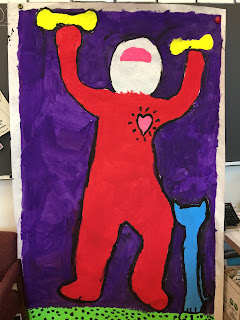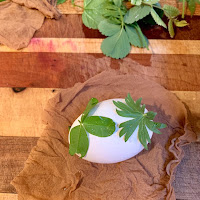TK/Kindergarten: Discovering Lines
Many people claim they cannot be artists because they "can't draw a straight line". Using the strategies of this unit "Discovering Lines" anybody who can hold a pencil can learn to draw. Drawing is basically a matter of close observation, breaking the subject into lines and shapes, and of course lots of practice.
This unit starts with a teacher/student discussion that anything we wish to draw, simple or complex, can be broken up into the "five line and shape families" (based on "Monart" methodology). Students learned that they can use lines to create a representational or an abstract piece of art.
Students practiced drawing a variety of lines and shapes by copying simple and complex line designs. Students learned that each line or shape starts with a dot. To draw objects and challenging designs students learned to "break-down"their subject into lines and shapes. By using a black felt tip marker (non-erasable), students learned to trust their drawing skills and take risks. Throughout this lesson students practiced visual and verbal line, and shape recognition.
This unit starts with a teacher/student discussion that anything we wish to draw, simple or complex, can be broken up into the "five line and shape families" (based on "Monart" methodology). Students learned that they can use lines to create a representational or an abstract piece of art.
Students practiced drawing a variety of lines and shapes by copying simple and complex line designs. Students learned that each line or shape starts with a dot. To draw objects and challenging designs students learned to "break-down"their subject into lines and shapes. By using a black felt tip marker (non-erasable), students learned to trust their drawing skills and take risks. Throughout this lesson students practiced visual and verbal line, and shape recognition.
1st GRADE: Design World, Blueprints
This lesson is part of a spiral course of study that builds on what students have learned previously (Discovering Lines), and it is introducing the 21st century thinking "STEAM" (academic disciplines of science, technology, engineering, arts and mathematics) concepts, and skills.
Students were given the task of designing an object, gadget, structure, or house. Starting with a pencil sketch in their art journals, students carefully contemplated their designs. "Who is it for?" "Is it functional?" "Is it comfortable?"
Students experimented and played with the ideas of architecture and design by creating blueprints. Students used recycled cardboard, paper tubes, and cups as printmaking tools. To complete the blueprints students added details, fitting titles and estimated measurements.
Students were given the task of designing an object, gadget, structure, or house. Starting with a pencil sketch in their art journals, students carefully contemplated their designs. "Who is it for?" "Is it functional?" "Is it comfortable?"
Students experimented and played with the ideas of architecture and design by creating blueprints. Students used recycled cardboard, paper tubes, and cups as printmaking tools. To complete the blueprints students added details, fitting titles and estimated measurements.
2nd GRADE: Abstract Line Art Single Registry Prints
This unit is a continuum of skills and knowledge students acquired during art classes in Kindergarten and First grade. After a discussion on "What is abstract art?" and after reading the book "The Dot" by Peter H. Reynolds, students were directed to create their very own abstract line art piece. A simple dot was the starting point for a practice sketch where students learned how to use a ruler to draw straight lines to divide their picture plane into sections. Each section was filled in, using the "five line and shape families base on the Monart methodology." Students transferred their sketch onto a styrofoam printing plate. Using a dull pencil students scratched and carved their abstract line designs into the foam.
Students were introduced to basic printmaking techniques. Students measured out the center point of a 9"X12" color construction paper. The center point of the paper was the single registry point for each of the 4 prints students produced. The repetitive action of the 4 prints lined up to a center point, created a single point perspective, and optical illusion effects.
Students were introduced to basic printmaking techniques. Students measured out the center point of a 9"X12" color construction paper. The center point of the paper was the single registry point for each of the 4 prints students produced. The repetitive action of the 4 prints lined up to a center point, created a single point perspective, and optical illusion effects.
Third grade students created moody water lilies as an interpretation of the works of Claude Monet (1840-1926), who was a founder of French Impressionist painting. He was the most consistent and prolific practitioner of the movement’s philosophy of expressing one’s perception of nature, especially as applied to “plein-air”, or outdoor, landscape painting. Monet was very fond of painting nature, using his own garden in Giverny, France, where his famous paintings of water lilies, ponds and bridges were inspired.
For this project, students learned about Monet’s life, and viewed samples of his work, taking notes and sketching in their art journals, then applying Monet's impressionistic and distinct style to their very own version of water lilies. Students prepared printing plates by carving a Water Lily scene into a piece of scratch foam. Students loved the hands on activity of printmaking creating 4 copies of their images in a variety of colors and color transitions, capturing impressions of different moods.
4th GRADE: Life-Size Posters inspired by Keith Haring
Four grade students were introduced to the works of Pop artist Keith Haring. Haring (1958-1990) was famous in the 1980s for his often large scale art, which was a mixture of graffiti and pop art. He used bright colors and simplistic, cartoon like images, expressing his social, emotional, and political views.
Student recorded important facts about Haring in their art journals and viewed samples of this work. Focusing on Haring's iconic imagery students analyzed a few samples of his works and used "his clues" (color, symbols, and motion marks) to identify, and guess Haring's message to the viewer.
Students sketched ideas to express a message or thought in a Keith Haring style. Students presented their ideas in assigned groups and worked on combining their ideas to create one large scale poster. Each group selected one-two students to act as models for their poster. Group members directed the models to lay down onto the poster paper in a specific pose and traced around their bodies. Each group carefully selected bright colors to paint their life size posters. Can you guess the students' message/idea/story they are communicating?





























